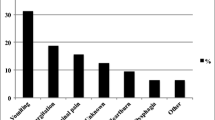Abstract
Background
Band slippage is a significant complication of laparoscopic adjustable gastric band (LAGB) surgery for the treatment of morbid obesity. This involves prolapse of part of the stomach, with varying degrees of gastric obstruction. The original perigastric technique (PGT) was associated with slippage rates of up to 25%. The pars flaccida technique (PFT) is the more commonly used technique today, reducing slippage rates to as low as 1.4%. We report a technique not previously described, the modified PFT with the use of mesh, and compare slippage rates between these three techniques for band placement.
Methods
A prospectively entered, retrospective review of 1,446 consecutive patients undergoing LAGB by a single surgeon was undertaken. Patients were divided into five consecutive groups: PGT learning curve (PGTLC) (n = 68), PGT (n = 19), mesh PFT (MPFT) (n = 415), mesh plication PFT (MPPFT) (n = 131), and MPPFT with inadequate follow-up (n = 813). Patient characteristics, band slippage, and other complication rates were compared between groups.
Results
The slippage rates for each group were: PGTLC (10%), PGT (5%), MPFT (0.8%), and MPPFT (0%). This demonstrated a statistically significant difference between the slippage rates for each group (p < 0.001). Combining the MPFT and MPPFT groups, there was a statistically significant difference in band slippage compared to the PGT group (p < 0.001).
Conclusion
While the MPFT is associated with low band slippage rates, the MPPFT results in further reductions in band slippage. The routine use of this modification to the MPFT is safe and may reduce operative morbidity. A randomized comparison of these techniques is warranted.


Similar content being viewed by others
References
Frigg A, Peterli R, Peters T, et al. Reduction in co-morbidities 4 years after laparoscopic adjustable gastric banding. Obes Surg. 2004;14:216–23.
Weiner R, Blanco-Engert R, Weiner S, et al. Outcome after laparoscopic adjustable gastric banding – 8 years experience. Obes Surg. 2003;13:427–34.
O’Brien PE, Dixon JB. Laparoscopic adjustable gastric banding in the treatment of morbid obesity. Arch Surg. 2003;138:376–82.
Ponce J, Paynter S, Fromm R. Laparoscopic adjustable gastric banding: 1,014 consecutive cases. J Am Coll Surg. 2005;201:529–35.
Wolnerhanssen B, Kern B, Peters T, et al. Reduction in slippage with 11-cm Lap-Band and change of gastric banding technique. Obes Surg. 2005;15:1050–4.
Keidar A, Szold A, Carmon E, et al. Band slippage after laparoscopic adjustable gastric banding: etiology and treatment. Surg Endosc. 2005;19:262–7.
Chevallier JM, Zinzindohoué F, Douard R, et al. Complications after laparoscopic adjustable gastric banding for morbid obesity: experience with 1,000 patients over 7 years. Obes Surg. 2004;14:407–14.
O’Brien PE, Dixon JB. Weight loss and early and late complications – the international experience. Am J Surg. 2002;184:42S–5S.
Zinzindohoue F, Chevallier JM, Douard R, et al. Laparoscopic gastric banding: a minimally invasive surgical treatment for morbid obesity: prospective study of 500 consecutive patients. Ann Surg. 2003;237:1–9.
Fielding GA, Allen JW. A step-by-step guide to placement of the LAP-BAND adjustable gastric banding system. Am J Surg. 2002;184:26S–30S.
Khoursheed M, Al-Bader I, Mohammad AI, et al. Slippage after adjustable gastric banding according to the pars flaccida and the perigastric approach. Med Princ Pract. 2007;16:110–13.
Weiner R, Bockhorn H, Rosenthal R, et al. A prospective randomized trial of different laparoscopic gastric banding techniques for morbid obesity. Surg Endosc. 2001;15:63–8.
O’Brien PE, Brown W, Smith A, et al. Prospective study of a laproscopically placed, adjustable gastric band in the treatment of morbid obesity. Br J Surg. 1999;85:113–8.
Pier A, Abtahi G, Lippert H. Surgical therapy of morbid obesity with laparoscopic “gastric banding”. Technique and results of 370 cases. Chirurg. 1999;70:196–205.
Zieren J, Ablassmaier B, Enzweiler C, et al. Disaster with a new type of band for gastric banding. Obes Surg. 2000;10:22–5.
Krukemeyer MG, Dietl KH, Loermann P, et al. A new laparoscopic technique for weight reduction with implanted gastric banding basket. Obes Surg. 2008;18:353–8.
Catona A. A method for treatment of gastric slippage after adjustable gastric banding. Obes Surg. 2003;13:318.
Boschi S, Fogli L, Berta RD, et al. Avoiding complications after laparoscopic esophago-gastric banding: experience with 400 consecutive patients. Obes Surg. 2006;16:1166–70.
Rubin M, Benchetrit S, Lustigman H, et al. Laparoscopic gastric banding with Lap-Band for morbid obesity: two-step technique may improve outcome. Obes Surg. 2001;11:315–7.
Rubin M, Spivak H. Prospective study of 250 patients undergoing laparoscopic gastric banding using the two-step technique: a technique to prevent postoperative slippage. Surg Endosc. 2003;17:857–60.
Spivak H, Favretti F. Avoiding postoperative complications with the LAP-BAND system. Am J Surg. 2002;184:31S–7S.
Wiesmer W, Weber M, Hauser RS, et al. Anterior versus posterior slippage: two different types of eccentric pouch dilatation in patients with adjustable laparoscopic gastric banding. Dig Surg. 2001;18:182–6.
Frydenberg HB. Modification of gastric banding, using a fundal suture. Obes Surg. 1991;1:315–7.
Zappa MA, Micheletto G, Lattuada E, et al. Prevention of pouch dilatation after laparoscopic adjustable gastric banding. Obes Surg. 2006;16:132–6.
Singhal R, Kitchen M, Ndirika S, et al. The “Birmingham stitch” – avoiding slippage in laparoscopic gastric banding. Obes Surg. 2008;18:359–63.
O’Brien PE, Dixon JB, Laurie C, et al. A prospective randomized trial of placement of the laparoscopic adjustable gastric band: comparison of the perigastric and pars flaccida pathways. Obes Surg. 2005;15:820–6.
Author information
Authors and Affiliations
Corresponding author
Additional information
Declarations
The content of this article has not been submitted or published elsewhere.
There was no source of funding for the article.
The authors declare that there is no source of financial or other support, or any financial or professional relationships that may pose a competing interest.
The manuscript has been seen and approved by all authors.
The cost of color figures will be met by the authors.
C.M. Thornton and W. M. Rozen are equal first authors.
Rights and permissions
About this article
Cite this article
Thornton, C.M., Rozen, W.M., So, D. et al. Reducing Band Slippage in Laparoscopic Adjustable Gastric Banding: The Mesh Plication Pars Flaccida Technique. OBES SURG 19, 1702–1706 (2009). https://doi.org/10.1007/s11695-008-9672-y
Received:
Accepted:
Published:
Issue Date:
DOI: https://doi.org/10.1007/s11695-008-9672-y




